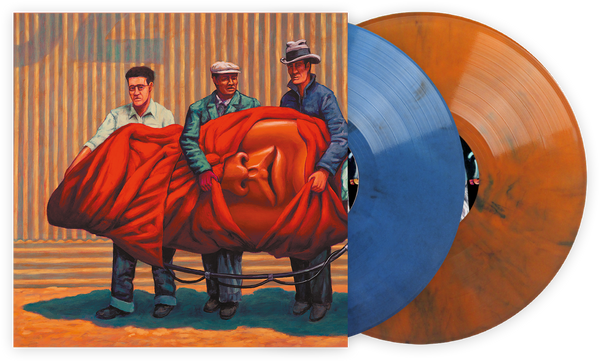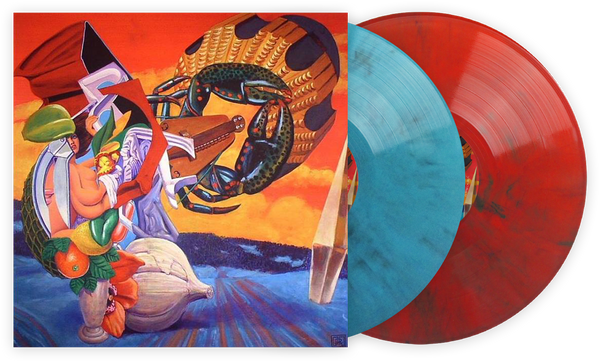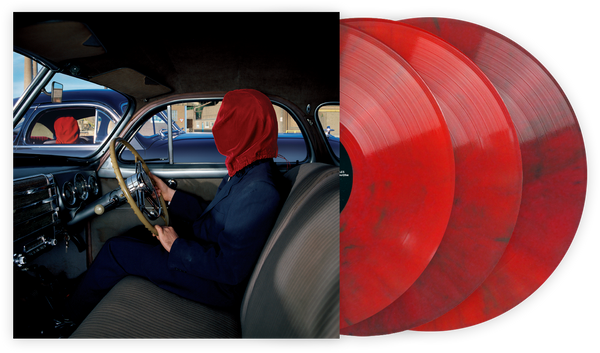The Mars Volta. Hvis du er fan, så forstår du — som meg — hvordan det er å prøve å få noen til å bli interessert i dette bandet. For det første, progressiv rock er ikke en sjanger som er lett å bli kjent med. Den blir ofte bevisst laget for å være utilgjengelig — disse lange, episke musikalske reisene tester ens tålmodighet i håp om at de kan omkalibrere lytteren og utvide deres musikalske smak. Dette kan absolutt sies om Volta, en gruppe som tok prog rock-grunnlaget fra grupper som Pink Floyd, Frank Zappa og King Crimson, og definerte — og redefinerte — sjangeren for 2000-tallet. Voltalederne, Omar Rodríguez-López og Cedric Bixler-Zavala, har aldri vekket unna sin egenbevissthet med dette bandet. De lager det de ønsker å høre; hvis du holder deg til dem, kult — hvis ikke, vel, det er også helt greit.
Med seks studioalbum på merittlisten, er jeg en fast troende på at Volta har noe for alle, selv om de ikke nødvendigvis mener at denne bandet gjør det. Selv om gruppen har holdt seg forankret i progrock gjennom disse seks albumene, har de eksperimentert med lyden på forskjellige måter — fra å gjøre den så maksimalistisk som mulig til å gi ut et album de omtaler som et akustisk album (selv om det teknisk sett ikke er det). Med det, har de også gitt ut en håndfull singler som viser deres variasjon også: triste valser og latin-funk-rock rytmer — en som til og med ga bandet deres første (og eneste) Grammy.
Men for å virkelig oppleve Volta, er det best å ta inn prosjektet deres slik de hadde tenkt: i sin helhet. Nå vet jeg hvor tøft dette kan være, spesielt for de som er indoktrinerte. Hvis det ikke er det skakke instrumenteringen, så er det Bixler-Zavalas stemme. Og i stedet for å gi deg svaret jeg pleide å gi folk som jeg trodde fikk meg til å høres så kul ut (“Du skjønner bare ikke Volta”), skal jeg bare si dette: Prøv og gi ett av disse albumene en sjanse basert på hvordan de er kategorisert. Enten du leter etter det mest tilgjengelige albumet eller kanskje bare en smakebit EP for å dyppe tærne i, håper jeg denne guiden vil hjelpe de nysgjerrige på Volta til å bli enten fans eller, i det minste, forstå hvorfor den vennen din elsker dem så mye.
Tilgjengelig er ikke et ord som vanligvis brukes om The Mars Volta, men de to albumene jeg ville anbefale er enten deres første album, De-Loused in the Comatorium, eller deres siste album, Noctourniquet. Det første er det beste av de to, bare fordi det føles som et Volta-album: konseptuelt, overbærende, episk — en ekte progrock-klassiker. Det siste har den ukonvensjonaliteten som har vært integrert i bandet siden starten, men det er mye mer rett frem og mindre ekstravagant. Det at Rodríguez-López har beskrevet Noctourniquet som «fremtids-punk» er nøyaktig. Det er et album som er mer i tråd med Antemasque (Rodríguez-López og Bixler-Zavalas kortvarige sideprosjekt) enn med Volta, og det gir et glimt av hva sistnevnte kunne ha vært hvis de hadde lener seg mer inn i sansene til deres elskede At the Drive-In med mer av en dash — snarere enn hele flasken — av deres progrock-eksperimentering.
Men også, De-Loused er albumet som startet det hele. De-Loused er ganske sammenhengende og fordøyelig sammenlignet med sine etterfølgere; Rick Rubins rolle som produsent rapporterer å ha bidratt til denne sammenhengen. Eksperimenteringen her er ganske tam; de filmatiske avvikene — den voksende stillheten som starter “Son et Lumière” eller de hule vann-drops ekkoene fra den andre halvdelen av “Cicatriz ESP” — er ikke overdreven, og får virkelig De-Loused til å føles som et konseptalbum. Sangene er strukturert på en enkel måte, selv om gruppen tar en uventet omvei i form av lange jam-sesjoner, slik som tilfellet er med den nevnte “Cicatriz ESP” (som inkluderer duel gitar soloer fra Rodríguez-López og John Frusciante) og albumavslutteren “Take The Veil Cerpin Taxt.” Alt dette er ment å hjelpe med å bringe fortellingen til De-Loused til livs, som, under Bixler-Zavalas gåtefulle tekster, faktisk er en hyllest til Julio Venegas. En musiker, maler og forfatter, Venegas døde 15. februar 1996, i El Paso, Texas, da han hoppet fra en overpas og falt ned på Interstate 10 under ettermiddagsrushtrafikk.
“Han var vår mentor, han lærte oss alt som skapte det vi er i dag, basically,” sa Bixler-Zavala om Venegas i et intervju med Rockcircustv fra 2004. “Julio er bare et eksempel på en sulten kunstner - noen som alltid kjempet, og når du kjemper, viser kunsten din, og han var en levende, gående legemliggjøring av hva kunst er eller hva det burde være.”
De-Loused føles — og høres — ut som en episk tragedie. Det er en tristhet tilstede gjennom hele albumet, mest bemerkelsesverdig på “Televators,” dets nest siste spor. “Televators” er et høydepunkt blant resten; det er en ballade som gradvis vokser i intensitet, drevet av Rodríguez-Lópezs akustiske gitar og Bixler-Zavalas vokaler. Hvis det er noen sang som oppsummerer briljansen til De-Loused, er det “Televators.” Men for å komme dit — og for å få albumet i det hele tatt — må du lytte til De-Loused i sin helhet. Albumet er en oppslukende opplevelse; det første av mange Volta-utgivelser som krever sine lyttere å begi seg inn i deres progrock avgrunn med full fokus, selv om du tilfeldigvis blir tapt underveis.
Det er viktig å merke seg at, tidligere i år, ga bandet ut Landscape Tantrums: Unfinished Original Recordings of De-Loused in the Comatorium. Mars Volta har aldri offisielt gitt ut noe som dette før. (Dette er grunnen til at, frem til dette punktet, hardbarkede fans har vært avhengig av peer-to-peer programvare som LimeWire og senere YouTube, for å lytte til bootleg grovversjoner av “Roulette Dares” og “Cicatriz ESP.”) Det er en godbit fordi det er intimt i sin råhet — fra den ubalanserte miksen som får alle instrumentene til å høres ut som de er på samme nivåer (den endelige versjonen av “Drunkship of Lanterns” skulle ha beholdt congas høyt som originalen) til “Televators” uten de atmosfæriske lydbildene som gjør den hva den er. Landscape Tantrums inkluderer også sannsynligvis tidligere medlemmer som Jane’s Addiction keyboardist Linda Good og bassist (og venn og langvarig samarbeidspartner med Rodríguez-López og Bixler-Zavala) Ralph Jasso, som viser hvordan disse medlemmene ikke bare bidro til hva De-Loused ble (den avdøde Jack White keyboardist Isaiah “Ikey” Owens og Red Hot Chili Peppers’ Flea endte opp med å spille inn tangenter og bass, henholdsvis), men også tilbød sin egen distinkte tolkning av disse sangene. Jeg ville anbefale å lytte til De-Loused før Landscape Tantrums, så du kan høre hvor mye som endret seg fra de originale opptakene til den endelige versjonen.
Utgitt i april 2002, Tremulant varslet hva som skulle komme med De-Loused in the Comatorium sin utgivelse året etter. Den tresporers EP-en inkluderer noe av bandets beste arbeid, spesifikt de to siste sporene: “Concertina” og “Eunuch Provocateur.” Det første er en vakkert trist vals; versene er stille, Rodríguez-Lópezs dissonante gitar ekko mellom Jon Theodores myke trommeruller og Eva Gardners uttalte basspicks. Når refrenget kommer, er bandet dynamisk og høyt, ledet av Bixler-Zavalas kryptiske tekster: “Will those shadows glare, from that blank-rimmed stare in a vacancy hush.” “Concertina” kan sees som en prequel til De-Loused; som albumet er sporet inspirert av Bixler-Zavala og Rodríguez-Lópezs kjære venn, den avdøde Julio Venegas. Men det er også trodd å handle om Ben Rodriguez, en tidligere turnegitarist for duoens forrige band, At the Drive-In, og hvordan han bidro til Venegas’ død. “Eunuch Provocateur,” som er der bandets debutalbumtittel kommer fra, er en energisk avslutning på EP-en; den latinrytmen som driver versene fungerte som en forløper til lignende sanger som De-Loused’s “Drunkship of Lanterns,” og viser hvordan bandet briljant fusjonerer sine latinske og punkrockrøtter for å skape en distinkt lyd.
Ved tiden for deres andreutgivelse, var Volta full-on progrock. Bare én sang fra Frances the Mute er under 10 minutter: Bandets første og eneste charting sang “The Widow” — som jeg antar er Kanye West-godkjent basert på denne tweeten — som slutter med en lang outro som åpenbart ikke ble med i sangens radio versjon. Resten er over 10 minutter, med ett spor som kommer inn på 32 minutter og 32 sekunder (“Cassandra Gemini”). Frances er det første Volta albumet som virkelig føles selvindulgent, og jeg mener det på en god måte. Så mye som fans er enige eller uenige om Rodríguez-López og Bixler-Zavalas uforbeholdne musikalske selvindulgence, legger det til appellen til bandet, og Frances er kanskje den mest sammenhengende — om enn fortsatt utfordrende — lytteopplevelsen og eksempelet på dette. Albumåpneren “Cygnus...Vismund Cygnus” slutter med tre minutter med ambient støy. “Cassandra Gemini” er delt inn i åtte deler. Frances tester ens tålmodighet, ikke bare med sanglengden, men med eksperimenteringen, og belønner lytterne med et nytt ambisiøst prosjekt som har noen av bandets største musikalske øyeblikk.
“Cygnus...” er strålende tempo: Den skakke groovet av første halvdel er så kraftig og punchy at når broen kommer, vil du varme motta den ambient stillheten, og gi deg et øyeblikk til å hente pusten før groovet kommer tilbake enda hardere. Og selvfølgelig, det er “L’Via L’Viaquez,” sporet godkjent av Guitar Hero World Tour som inkluderer to brennende gitar soloer fra Frusciante, samt en fenomenal pianoso fra den avdøde legendariske salsa pianisten (og en av Rodríguez-Lópezs største påvirkninger) Larry Harlow.
Frances varslet Rodríguez-Lópezs diktatoriske tilnærming frem til deres siste album, Noctourniquet. Hvor De-Loused hadde Rubin til å hjelpe Rodríguez-López med å begrense sine mer avant-garde avvik, ble Frances (og hvert Volta-album deretter) produsert av Rodríguez-López alene. Dette er kanskje grunnen til at dette albumet er mer ambisiøst og ikke-tradisjonelt. Rodríguez-López kanalisert sin indre filmregissør og instruerte bandmedlemmene sine om å bringe hans kunstneriske visjon til liv.
Amputechture er ansett som albumet som delte Volta-fansen i to: de som ønsket at bandet skulle gå tilbake til en eksperimentell — men fortsatt fordøyelig — lyd à la De-Loused, og de som ønsket at bandet skulle gå dypere inn i progrockens ukjente territorier slik de gjorde med Frances. De som tilhørte den siste kategorien var sikkert mer mottakelige for Amputechture, som er lett et av bandets mest utfordrende utgivelser. Tre av Amputechture's spor er over 10 minutter lange, hver med flere musikalske bevegelser. På grunn av dette er Amputechture kanskje Voltas mest filmatiske album, med Rodríguez-López som implementerer en svært direktorial tilnærming til prosjektets skapelse.
“Prosessen jeg har brukt på de to siste Mars Volta-albumene er at alt blir spilt inn ute av rekkefølge og ute av sekvens,” sa han i et intervju fra 2006 med Guitar World. “En dag kan jeg spille inn alt som er i en bestemt toneart. En annen dag kan jeg spille inn alt veldig mykt, eller alt som er høyt og abrasive. Så spillerne har egentlig ikke en kontekst for hva som kommer før og etter, eller hvordan de interagerer i sangen.”
Amputechture er så å si Voltas mest kompromissløse utfordring, og maleren Jeff Jordans coverart for det legemliggjør det. Urovekkende og bisarre, men også merkelig vakker og fengslende, Jordans verk, “Big Mutant,” er et passende bilde for albumet. Hvis du finner deg selv avskrekket av Amputechture, så i det minste lytt til Juan Alderetes rasende basssolo i starten av “Day of the Baphomets,” og så se denne videoen av gruppen som spiller sangen live på The Henry Rollins Show for å se hvor brilliant Alderetes solo er.
Hvis du noen gang har sett komedien fra 2010 Get Him to the Greek, så har du hørt en del av Scabdates før. En kulminasjon av liveopplevelser fra mai 2004 til mai 2005, Scabdates fusjonerer disse opptredenene med feltopptak — fra gråtende babyer til backstageprat — for å lage et livealbum som skal lyde som om det kom fra én enkelt opptreden. Sluttresultatet gjør for et ukonvensjonelt livealbum som fanger den gåtefulle ethosen til Volta, så vel som deres energiske og improviserte liveopptredener. For en mer direkte livealbumopplevelse, er det også deres 2003 Live EP, som består av fire opptak: to fra Londons XFM Studio (“Roulette Dares (The Haunt Of)” og “Drunkship of Lanterns”) og to fra Londons Electric Ballroom (“Cicatriz ESP” og “Televators.”) Selv om ingen av platene er tilgjengelige på strømmetjenester, er de tilgjengelige på YouTube.
The Bedlam in Goliath har det som lett er den mest fascinerende bakhistorien til noe av Voltas album. På en reise til Jerusalem, kjøpte Rodríguez-López Bixler-Zavala et Ouija-brett som gave, som de to brukte under deres 2006-turné med Red Hot Chili Peppers. Jo mer de brukte det, jo mer merkelige ting begynte å skje med dem mens de skrev og spilte inn albumet — fra Rodríguez-López' hjemmestudio som flommet til albumets originale ingeniør som fikk et mentalt sammenbrudd. I håp om å oppheve forbannelsen som brettet la på albumet, brøt Rodríguez-López det i to og gravde det ned.
Bedlam's opprinnelseshistorie passer den generelle apokalyptiske atmosfæren til albumet. Hver sang har en mørke og intensitet til seg, primært takket være den dynamiske og kraftige trommingen til Thomas Pridgen. Men i sin tyngde byr Bedlam på noen av bandets mest populære sanger, inkludert den Grammy-vinnende singelen, “Wax Simulacra,” og “Goliath,” sistnevnte som er en raskere — og dramatisk mindre chill — versjon av “Rapid Fire Tollbooth” fra Rodríguez-Lópezs Se Dice Bisonte, No Búfalo album. Ærlig talt, Bedlam er det minst chill Volta-albumet i bandets diskografi, som er en del av dets appell. Det er deres høyeste og hardeste album, med hvert medlem som spiller — og i Bixler-Zavalas tilfelle, synger — sine respektive instrumenter som om livet deres avhang av det. Som, gitt at Ouija-brettet kanskje eller kanskje ikke har ført til at Bixler-Zavala måtte ha fotoperasjon, kanskje livet deres faktisk avhang av det.
Dette kan være en hete mening, men når det kommer til Voltas to ikke-konseptalbum (Amputechture og Octahedron) er det sistnevnte det bedre valget totalt sett. Ikke bare inkluderer oppfølgeren til Bedlam mer minneverdige sanger — mest bemerkelsesverdig den kraftfulle “Cotopaxi” og den vakre åpningssangen “Since We’ve Been Wrong” — men det er en så forfriskende avvik fra alt bandet hadde gjort frem til det punktet. Beskrevet av Bixler-Zavala som “vår versjon av hva vi anser som et akustisk album,” Octahedron er bemerkelsesverdig naken. For det første, Adrián Terrazas-González, samt rytmegitarist og lyddesigner Paul Hinojos, var ikke lenger en del av bandet. Også, Isaiah “Ikey” Owens, som hadde bidratt med tangenter til bandets album siden De-Loused, var ikke med på albumet.
“Det er som om vi fikk et helt nytt band,” sa Volta-medlem (og en av Rodríguez-Lópezs brødre) Marcel Rodríguez-López i et intervju i 2009 med Drum magazine. “Det er to færre medlemmer — vi måtte spille annerledes.”
Det er denne nakenheten som gjør Octahedron så fascinerende. Så mye av Volta er storslått: Hvor mye kan vi få inn i én sang? Hvor mange lyder kan vi få inn i én sang? På Octahedron er det åpenbart at de ikke really var bekymret for disse spørsmålene. De gikk for lettere og mer rett frem sanger som viser at de kan være strukturelt konvensjonelle samtidig som de opprettholder lyden de er kjent for. Jeg ville gå så langt som å si at “Since We’ve Been Wrong” er en av deres beste sanger, spesielt fra et låtskrivings ståsted. Skjønnheten i de to motstående gitarmelodiene, Bixler-Zavalas smittende hook og Pridgens tordnende trommer som kommer til midtpunktet — det er så briljant tempo og strukturert, men forblir fortsatt utvilsomt Volta.
Elijah Watson is the Senior News & Culture Editor for Okayplayer. He has written for publications like The FADER, the Daily Beast and Complex. His work has been included in books like the Best Damn Hip Hop Writing: 2018, and he’s also a Webby Award winner. When he’s not writing or editing, he’s usually sleeping or watching video game explainer videos on YouTube.



